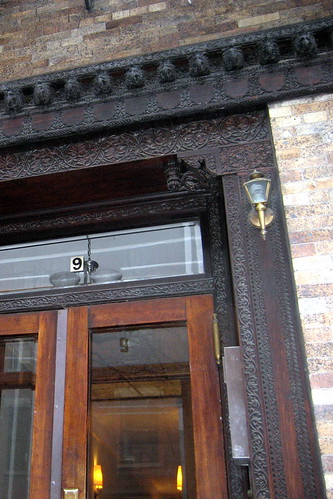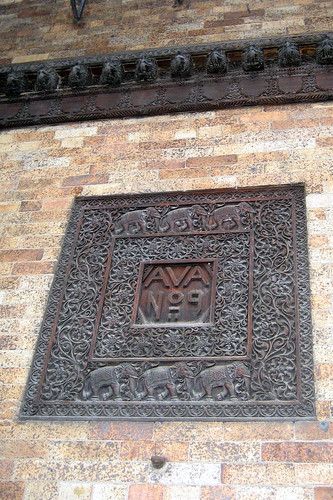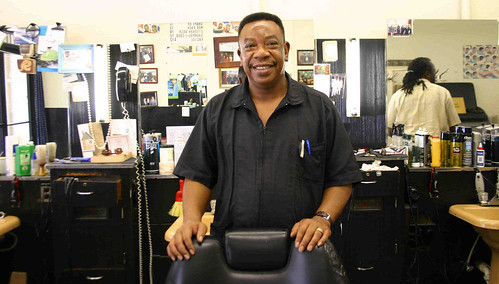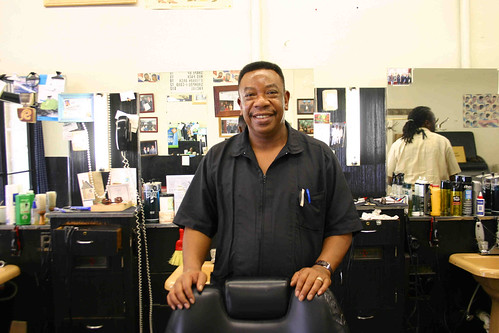NYC - Greenwich Village: The Alva
Image by wallyg
Lockwood De Forest, a co-founder of the Associated Arts, a decorative arts atelier with Louis Comfort Tiffany and Candice Wheeler in 1879, who designed his house next door at 7 East 10th Street, sold this lot to architect William H. Russell in 1888. Russell decided to mimic DeForest's building with his use of teak decoration on the cornice and first-floor trim are in teak carved in a fashion.
In 1890 Russell sold the building to Christian Tietjen, a banker and lard manufacturer, who used it for rentals. The earliest tenants were people like John Beavor-Webb, yacht designer and intimate of J. P. Morgan, and Dr. Alexis Carrel, who won a Nobel prize in 1912 for his work in organ transplants and surgical techniques. As the Village became popular among artists, it attracted people like Helen Dryden, who was described in 1956 as the highest paid female artists in the country, and Dawn Powell. The ground-floor entryway and hall have since been renovated up with new woodwork and a paint job.
NYC - Greenwich Village: The Alva
Image by wallyg
Lockwood De Forest, a co-founder of the Associated Arts, a decorative arts atelier with Louis Comfort Tiffany and Candice Wheeler in 1879, who designed his house next door at 7 East 10th Street, sold this lot to architect William H. Russell in 1888. Russell decided to mimic DeForest's building with his use of teak decoration on the cornice and first-floor trim are in teak carved in a fashion.
In 1890 Russell sold the building to Christian Tietjen, a banker and lard manufacturer, who used it for rentals. The earliest tenants were people like John Beavor-Webb, yacht designer and intimate of J. P. Morgan, and Dr. Alexis Carrel, who won a Nobel prize in 1912 for his work in organ transplants and surgical techniques. As the Village became popular among artists, it attracted people like Helen Dryden, who was described in 1956 as the highest paid female artists in the country, and Dawn Powell. The ground-floor entryway and hall have since been renovated up with new woodwork and a paint job.
01a.CarlsBarberShop.14P.NW.WDC.30may06
Image by Elvert Barnes
Carl Lewis, owner & operator . Carl's Barber Shop . www.carlsbarbershopdc.com/ . 1406 P Street, NW . WDC . Monday, 30 May 2006 . Elvert Xavier Barnes Photography
_______________________
Carl Lewis has been the owner of Carl's Barber Shop since July 2000 which is when he took over its operation from his mentor and then owner, Timothy Pearsall.
First located at 17th and R Streets, in NW, Timothy Pearsall, owned and operated Neighborhood Barbershop for more than 40 years. It was in 1985 that Timothy Pearsall would relocate his Neighborhood Barbershop to the Logan Circle area at 1406 P Street in NW WDC. It was also in the spring of 1985 that would move to the Logan Circle area, at 1320 Q Street, which is just one bloick north and 1/2 block east from the barbershop.
In late November 2004, I relocated back from NYC to WDC and after a few months of sharing a house on Morningside Lane in Alexandria VA with my then partner and future house mate, Greg, and his best friend Mike and Mik'es lover Smitty In late April or early May 2005, which is when Greg and I would split up (again), I would move back into the city which is where I had lived for many years before moving to NYC.
I had met Johnnie Jackson and George Dague through catering work with Design Cuisine. When they heard that I was looking for a place back in the city they suggested that I share 1320 Q Street with them. And since we all worked in catering it would prove to be a good situation. At the time I would begin work in the accounting office at the newly opened Washington Convention Center.
It was at Jonnie's suggestion that I visited the barbershop down the street and around the corner which, at the time, was known as the Neighborhood Barbershop. Though he was close friends with a high fashioned hair designer who often cut his hair, Johnnie Jackson, also frequented Neighborhood Barbershop on a regular basis.
As have I ... since his introduction.
At the time, it's customer's base was mostly black. Which would be the case until 2000, according to Carl Lewis. Who during a brief interview that I conducted with him, on 30 May 2006, said that from when it first opened, at the location, in 1985 through 2000 that it's customer's base was 95 % black. But, that in 2000 he'd noticed a gradual but considerable change. And that by 2002 it's black customer base was 60 about 60 % and that whites and others made up the remaining 40 %.
And though there has always been a steady latino base, in recent years, the number of latino customers have been on the rise as well
Born in 1950, Carl Lewis, has been married for 35 years. He and his wife would raise their three children in PG County Maryland. A son at 23 and two daughters at 26 and 3, none who plan a career in the barber profession. Origianally from Fayettsville NC, Mr. Lewis would work with the WMATA Metro for 27 years, as a transit opertor, before retiring.
From 1986 through 1996 he barbered, part-time, at Timothy Pearsall's Neighborhood Barbershop at 1406 P Street. Upon retiring from WMATA in 1996, he would barber full-time, until 1997 and then take some time off before purchasing the business from Timothy Pearsall in July 2000.
It was at that time he would change the name to Carl's Barber Shop.
Since my first visits, in 1985, to what was then the Neighborhood Barber Shop, I had hoped to include this particular barber shop in my ongoing Barber Shop Documentary Project. Though, over the years since 1992, I have often photographed the exterior and window displays of what is now Carl's Barber Shop it would be on _____ that for the second time that I would approach the owner saying that I wish to do a photoessay of his shop.
It would be the second time that I would approach the owners pertaining to this project. And while I can not now recall exactly when I had actually approached the former owner, Timothy Pearsall, perhaps in the late 90's with the same proposal. At which time, over a series of several months, I would take several pictures. Which at this time I can not now locate. Some of which I may not yet processed since they were taken with the 35 mm camera.
This is a project that has been on my mind for many years.
One of the reasons that I had been interested in capturing this particular barber shop at this location has a great deal to do with the fact that it had to do with it's 'blackness'. And while all have always been welcomed, it has maintained its culture and heritage.
Jonnie Jackson and I would have indepth conversataions about such matters and the importance of black owned businesses. While I welcome any and all, my concern, as black man, is that, along with the many changes, a disproportionate number of blacks, many who own businesses, are being pushed out. So, not only are blacks losing their busineseses and means for an income but in the process of change ... also our heritage. And culture.
And while I am sure that such is the case with most ethnicities, and especially, in the black community, barber shops and beauty parlors, are just as important and may have a similar impact on the black community as does the black church.
Let me reiterate. Black barber shops and black beauty parlors are as important to the black community as is the black church. It is a ritual for many black women to visit her beautician every two weeks. Just it is a ritul for many black men to visit their barbers, every two weeks.
Which brings up another matter, that jonnie and I would often discuss. Or debate on. While I'm certainly black and am fulling rooted in my history, many of my friends think of me as being 'not black enough.' Mainly because I do not necessarily adhere to particular 'black rituals'.
It will be several weeks and sometimes a month before I may have my hair cut. And while I can appreciate those who practice their religion I am not into the black church thing and, in many cases, am in disagreement with many of the practices and preachings of most churches. Including some that are often associated with what what some refer to as a the 'black church'.
And, yet, I am cognitive of the importance of the black barber shop, its history and contribiutiuons not only to the black community but to the American cultire.
From my observation, Carl Lewis, is an important reflection of an important aspect of the black community. Similar to Charles Brice who owns Brice's Barber Shop on Captiol Hill, though both had worked part-time, for many years, as barbers often for their mentors it was after retiring from their jobs that they would purchase a barber shop.
According to Mr. Lewis since July 2000, his rent has increased over 200%.
At a basic rate of per hair cut, it does not take a rocket scientist to understand that the day may come when neighborhood barber shops in the Logan Circle area will not longer exist. just as such barber shops no longer exist at 17th and R Streets, or in many of the places that they once thrived.
Each time that I walk pass Carl's Barber Shop I remember how I felt, in 1985, when I first visited what was then the Neighborhood Barber Shop. To better shed light on this feeling, allow me share my expereeinces on ______ which was the last time that I would have my hair cut before Tuesday, 30 May 2006.
On that particular Saturday evening, and as I often do when passing Stead Park, I photograph basket ball players. Who mostly were black men. but one or two white guys, two latinos. and a black female on looker.
While I do not usually have a problem with the white players, several of the black players began to shout and yell at me. Something to the effect that "I better not see any of your pictures of me in the Blade.' And though I have often observed whites standing in the exact same postion as I, who are taking pcitures, it is a reaction I I often get from other blacks.
Even though I've been taking pictures, for many years. I shotted back, 'I don't work for the Blade. I work for me. This is about me, a black man, documenting and recording my life ... from my perspective.
And, had I been a white guy, gay or straight, the black guys would have had a very different reaction to me. In a similar way, if I were a white documentary photographer and focusied on the things that I do, including barber shops I would have a very different reaction than what I do.
So, when I now reflect on that particualr day that I had goten my hear cut at Carl's Barber Shop ... I sometimes remember that just after leaving the barber shop that a group of basketball players in Stead Park, threated me.
It was also during that same visit, that I would discuss with Mr Lewis and his staff that in recent months I had been photographing his windows and now wish to photograph the interior as well as do a photo project of him and his staff. In the back of my mind, I could not get out of my head the comment that the two or three basketball players had said 'I know who you are and you better watch out ....".
Which speaks to the matter of gentrificatation. Though I have lived in the Logan and Dupont Cirlces areas for many years, as is evidenced by the fact, that most people know me, as a 52 year old black man not only have I been pushed out, verbally and on some occasions physically assulted in the streets but I am less welcomed now then I was when I would first visit these areas.
As i walked into Carl's Barber Shop on that Saturday afternoon, ______. Motown songs were playing on the music box. The shop was just about to close, but one barber said come on in. I sat in the chair. He wrapped the apron around my torso. I said 'take it all off, and even all the way around. It's getting hot outside."
There was one man sweeping and cleaning up the shop. He joked and said 'I'm tired of working. I want to get out of here and go home. My barber laughed back and said "only our people would come to a job, late, and say I'm tired of working.;
Everybody would burst into laugher. By this time he was finishing up with my hair. Marvin Gay'es song "I Heard Through the Grapevine" come be in the background. It brought backto mind, when I would first visit the shop in 1985. It was as if I had come home.
I'd ask how. He say . I'd hand him a and say keep the change. We had already discussed my documentary project, reflecting on what had occured moments before in Stead Park, I'd say I'll come back and take picturess.
I'd leave the shop and head to Dupont Circke, wondering if any of the black guys from Stead park would follow and/or jump me.
UNDER CONSTRUCTION . Elvert Xavier Barnes Photography . Writings . Ads
01.CarlsBarberShop.14P.NW.WDC.30may06
Image by Elvert Barnes
Carl Lewis, owner & operator . Carl's Barber Shop . www.carlsbarbershopdc.com/ . 1406 P Street, NW . WDC . Monday, 30 May 2006 . Elvert Xavier Barnes Photography
_______________________
Carl Lewis has been the owner of Carl's Barber Shop since July 2000 which is when he would take over its operation from his mentor and then owner, Timothy Pearsall.
First located at 17th and R Streets, in NW, Timothy Pearsall would own and operate Neighborhood Barbershop for more than 40 years. It was in 1985 that Timothy Pearsall would relocate his Neighborhood Barbershop to the Logan Circle area at 1406 P Street in NW WDC. It was also in 1985 that I would move to the Logan Circle area, at 1320 Q Street, which is just one bloick north and 1/2 block east from the barbershop.
In late November 2004, I would relocate back from NYC to WDC and after a few months of sharing a house on Morningside Lane in Alexandria VA with my then partner and future house mate, Greg, and his best friend Mike and Mik'es lover Smitty In late April or early May 2005, which is when Greg and I would split up again, I would move back into the city which is where I had lived for many years before moving to NYC.
I had met Johnnie Jackson and George Dague through my catering work with Design Cuisine. When they heard that I was looking for a place back in the city they suggested that I share 1320 Q Street with them. And since we all worked in catering it would prove to be a good situation. At the time I would begin work in the accounting office at the newly opened Washington Convention Center.
It was at Jonnie's suggestion that I visit the barbershop down the street and around the corner which, at the time, was known as the Neighborhood Barbershop. Though he was close friends with a high fashioned hair designer who would often cut his hair, Johnnie Jackson, would also frequent Neighborhood Barbershop.
As would I, after his introduction.
At the time, it's customer's base was mostly black. Which would be the case until 2000, according to Carl Lewis. Who during a brief interview that I would conduct with him, on 30 May 2006, would say that from when it first opened, at the location, in 1985 through 2000 that it's customer's base was 95 % black. It was in 2000 that he'd noticed a gradual but considerablechange. And that by 2002 it's black customer base was 60. While whites and others made up the remaining 40 %. And though there has always been a steady latino base, in recent years, the number of latino customers have been on the rise.
Born in 1950, Carl Lewis, has been married for 35 years. He and his wife would raise their three children in PG County Maryland. A son at 23 and two daughters at 26 and 3, none who plan a career in the barber profession. Origianally from Fayettsville NC, Mr. Lewis would work with the WMATA Metro for 27 years, as a transit opertor, before retiring.
From 1986 through 1996 he would barber, part-time, at Timothy Pearsall's Neighborhood Barbershop at 1406 P Street. Upon retiring from WMATA in 1996, he would barber full-time, until 1997 and then take some time off before purchasing the business from Timothy Pearsall in July 2000.
It was at that time he would change the name to Carl's Barber Shop.
Since my first visits, in 1985, to what was then the Neighborhood Barber Shop, I had hoped to include this particular barber shop in my ongoing Barber Shop Documentary Project. Though, over the years since 1992, I have often photographed the exterior and window displays of what is now Carl's Barber Shop it would be on _____ that for the second time that I would approach the owner saying that I wish to do a photoessay of his shop.
It would be the second time that I would approach the owners pertaining to this project. And while I can not now recall exactly when I had actually approached the former owner, Timothy Pearsall, perhaps in the late 90's with the same proposal. At which time, over a series of several months, I would take several pictures. Which at this time I can not now locate. Some of which I may not yet processed since they were taken with the 35 mm camera.
This is a project that has been on my mind for many years.
One of the reasons that I had been interested in capturing this barbershop at this location has a great deal to do with the fact that it had to do with it's 'blackness'. And while all have always been welcomed, it has maintained its culture and heritage.
Jonnie Jackson and I would have some very indepth conversataions about such matters and the importance of black owned businesses. While I welcome any and all, my concern, as black man, is that, along with the many changes, a disproportionate number of blacks, many who own businesses, are being pushed out. So, not only are blacks losing their busineseses and means for an income but in the process our heritage. And culture.
And while I am sure that such is the case with most ethnicities, and especially, in the black community, barber shops and beauty parlors, are just as important and may have a similar impact on the black community as does the black church.
Let me reiterate. Black barber shops and black beauty parlors are as important to the black community as is the black church. It is a ritual for many black women to visit her beautician every two weeks. Just it is a ritul for many black men to visit their barbers, every two weeks.
Which brings up another matter, that jonnie and I would often discuss. Or debate on. While I'm certainly black and am fulling rooted in my history, many of my friends think of me as being 'not black enough.' Mainly because I do not necessarily these two rituals. Among, a few others.
It will be several weeks and sometimes months before I have my hair cut. And while I can appreciate those who practice their religion I am not into the church thing and, in many cases, am in disagreement with many of the pracices and preachings of most churches. Including what is often referre to as the 'black church'.
And, yet, I am cognitive of the importance of the black barber shop, its history and contribiutiuons not only to the black community but to the American cultire.
From my observation, Carl Lewis, is an important reflection of an important aspect of the black community. Similar to Charles Smith who owns Brice's Barber Shop on Captiol Hill, though both had worked part-time, for many years, as barbers often for their mentors it was after retiring from their jobs that they would purchase a barber shop.
UNDER CONSTRUCTION . Elvert Xavier Barnes Photography . Writings . Ads
No comments:
Post a Comment